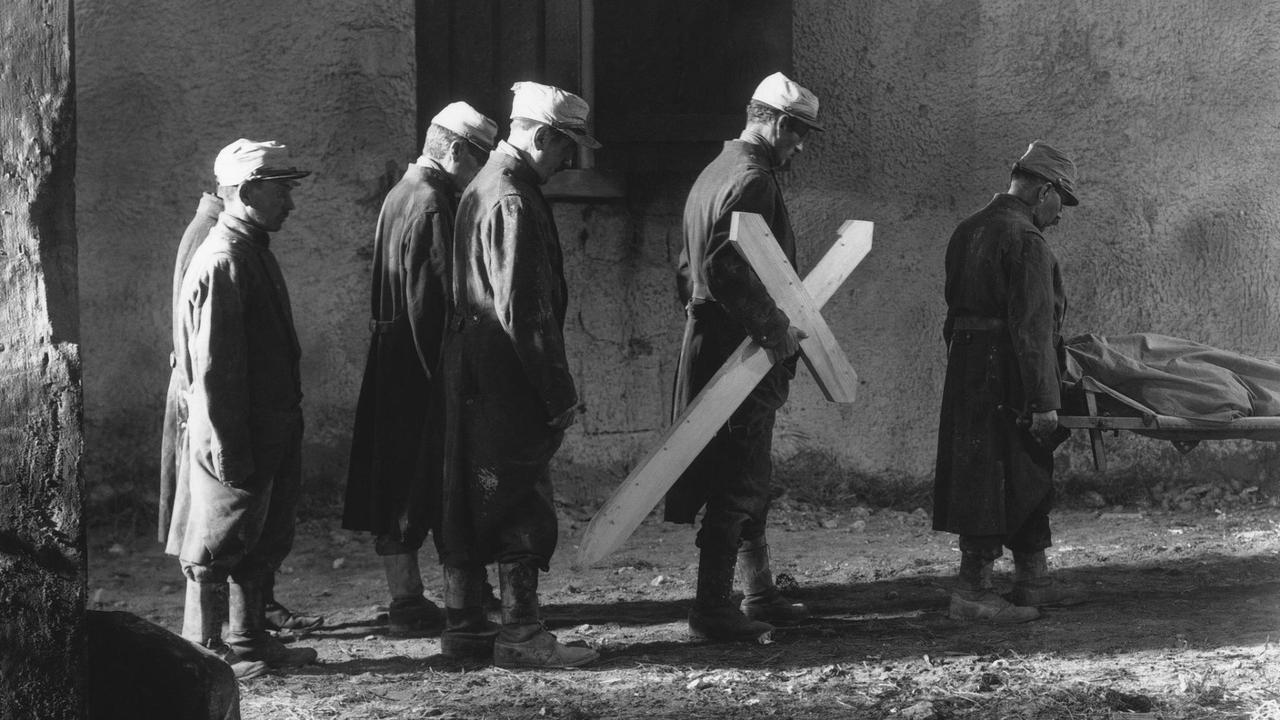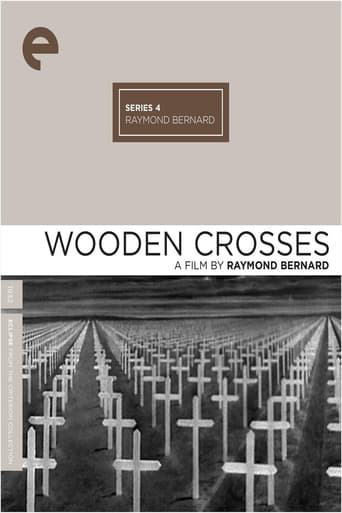

One reviewer accuses "Les Croix de Bois" of not giving any reason/explanation/philosophical whatever for the Great War.He terribly missed the point."Les Croix de Bois" is adapted from one of the most famous French novel written about WWI. Roland Dorgeles was a veteran and his main purpose was to talk about his own experience and not "to make a point" against war. The movie is just about that. Recrating an experience. A terrible one.Raymond Bernard was himself a veteran and it shows. The depiction of the life in the trenches is vivid. We feel under our skin the misery of the soldiers, their small moment of joy and their fear in front of something to big to be comprehended. You do not think of philosophy when machine guns are screaming at you.Raymond Bernard employed a lot of actors and crew members who actually were in the trenches and he managed to show war on a daily basis from the smallest event to the major assaults. The 10 minutes battle in the middle of the film is so realistic that it looks like a war documentary. In the early thirties the former battle sites were not just memories. The scars were still there. Waiting for the next ones.The acting is a bit dated, particularly Pierre Blanchar who has a tendency to overplay and is far too old for the role. But he fought too during the war and his fixed eyes are the result of a gas attack.This movie is to be put alongside "Battleground" or "A Walk in the Sun". The Zero Level of War. Just Men alone and scarred. No reasons, no explanations, and certainly no Philisophy.
... View MoreThe film "Wooden Crosses" 1932 was a pretty good film. It was about a handful of soldiers who fought in the second world war. The conversation did not go deep into the psyche of the individuals instead the images and the silence seemed to tell the story. The banging of machine gun fire, the tension between the two countries (Germany and France) and the friendships being made in the trenches where lasting communications prevailed.The sequencing of images was amazing. I remember sitting watching the movie and experiencing the absolute continuity of the camera frames. The sound of the pull-back on the mechanical canon was like a metal thug rejecting and re-surging. It was a very unique sound that seemed to bring me into the battlefields.The pain and agony in the eyes of the actors was something that I found to be very real. There was no senseless blood pouring out - instead there was raw emotion and pain present.The despair was stealth with bravery, courage and hope.At the end of the film the lead character has a hallucination - one of wealth and success versus one of white wooden tombstone crosses. The final hallucination was what makes this film last the test of time. The hallucination captured the patriotism and ends with the disillusionment of one individuals life. It captures the attempt at happiness and ends with the realization of death and nothingness.A great movie to watch on an Autumn evening in Canada. A time when the leaves are falling off the trees and when the nature from the summer seems to fade away like apples on a tree.Annuska. Canada.
... View More1930 saw two great anti-war films about WWI--"All Quiet On the Western Front" and the German-made "Westfront 1918". Both were unrelentingly grim and accurate in their portrayal of war as a never-ending hellish existence. These were certainly NOT the glorious depictions of war you usually see for WWII. This is for several reasons. First, WWI was unusual in its brutality and pointlessness for the average soldier--far,far worse than wars before or since. Second, the 1930s was an era when the reality of the past war had finally sunk in--that many millions had essentially died for nothing. As a result, the anti-war movement was exceptionally strong. Third, unlike the films made during WWII which were made to bolster the war effort, this WWI type of film was made to show how war sucks and should not be fought--or perhaps how not to fight it.While "Wooden Crosses" is one of the great anti-war films of this era, it's not one of the very, very best (such as the two mentioned above). The biggest reason is that the characters are more ill-defined--and so one person looks pretty much like another. This makes for a less satisfying film--but also perhaps reiterates the anonymity of war. And, I must point out, it does a terrific job of showing what war is like--with gobs of explosions and death. But, because other films had come out before it that were just a bit better, this film somehow got lost in the process. A truly exceptional film--but try the other two first. And, if you'd like, also try "The Eagle and the Hawk" as well as "Ace of Aces"--two excellent American anti-war films that truly personalize the awfulness of war.
... View MoreComments on this film are bound to centre around comparisons to All Quiet On the Western Front - reasonably enough, since Wooden Crosses was specifically made as a rival to that film. It isn't as engrossing as Milestone's classic, perhaps because it never really characterises the soldiers strongly enough, and also because it lacks the variety of incident which makes All Quiet so entertaining despite its grim subject matter and episodic structure.But both these flaws are also strengths: Bernard's skill in conveying the de-humanising effects of war, as well as the sheer repetitious tedium of the ordinary soldier's experience, lend to his film a bitterness and realism which its - occasionally naive - American predecessor lacked. There are one or two scenes in this film so bitter and horrifying that no war film matched them until at least the 1950s.For this reason, the film may find more sympathy with today's audiences, who - after Apocalypse Now, Full Metal Jacket, The Thin Red Line, Jarhead etc - expect a war film to immerse them in sheer violent futility for two hours, and are likely to regard lack of incident as a mark of authenticity.This film is nothing if not authentic (the cast was made up entirely of war veterans), and the documentary realism of the battle scenes was a real shock to me. Complaints that, unlike most war films, it makes no reference to the wider context of the war, are understandable...but I think they miss the point. The film is indeed a violent mess: what else must it have felt like for the men in the trenches? Wooden Crosses faithfully plays out Lew Ayres' famous speech from All Quiet (maybe paraphrasing here): 'We live in the trenches and we fight. We try not to get killed. That's all.' I thought I already knew how inventive and daring early '30s film-makers were, but just on the strength of this film (haven't watched Les Miserables yet...) Bernard deserves to stand with the best of them - Lang, Milestone, Vidor, Eisenstein. The lyrical beauty of so many of the images in Wooden Crosses, and the intense horror of some others, left me gaping in disbelief at the screen, and will always stay with me. Perhaps because it's 76 years old, and because it's such an unsung pioneer, this film makes me revert to clichés and superlatives. But it really is one of the very best war films ever made.
... View More